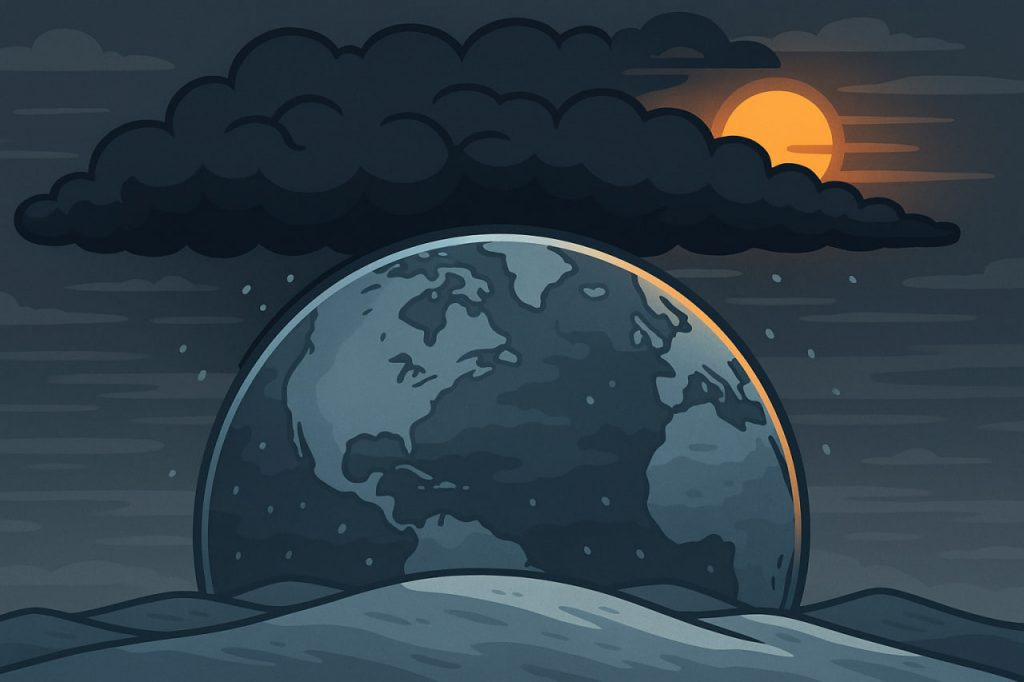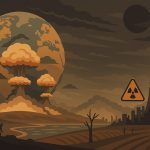The term “nuclear winter” describes a devastating climatic consequence of large-scale nuclear war — a drastic and prolonged global cooling caused by massive fires, smoke, and soot filling the atmosphere. This concept emerged during the Cold War when scientists realized that the danger of nuclear conflict went far beyond explosions and radiation. A full-scale exchange of nuclear weapons could alter the planet’s climate, block sunlight for years, and collapse the ecosystems that sustain human life.
The Origin of the Concept
The theory of nuclear winter was first developed in the early 1980s by a group of scientists including Carl Sagan, Richard Turco, and Brian Toon. Using climate models, they simulated what would happen if hundreds or thousands of nuclear bombs were detonated in cities and industrial zones. The resulting fires, they found, would inject tens of millions of tons of black soot into the stratosphere — enough to block sunlight globally.
This discovery changed the way policymakers thought about nuclear weapons: even “winning” a nuclear war would lead to a shared planetary catastrophe.
How Nuclear Winter Would Develop
1. Massive Firestorms
Each nuclear explosion ignites citywide fires fueled by buildings, vehicles, and petroleum products. The largest urban areas could burn for days, sending enormous plumes of smoke into the upper atmosphere.
2. Soot in the Stratosphere
Unlike ordinary pollution, this black carbon smoke rises high enough to remain in the stratosphere, where rain cannot wash it away. Once there, it would form a dark global layer that absorbs sunlight.
3. Global Darkness and Cooling
Within weeks, sunlight reaching Earth’s surface could drop by 70–90%, causing global temperatures to plummet by up to 10–20°C. Even tropical regions could experience frost and snow.
4. Collapse of Agriculture
With less sunlight and lower temperatures, photosynthesis would slow dramatically. Crops would fail worldwide. A famine affecting billions could follow within months.
5. Acid Rain and Radiation
In addition to darkness and cold, radioactive particles and chemical reactions in the atmosphere would produce acid rain, contaminating soil and water supplies.
The Duration of a Nuclear Winter
Depending on the scale of the conflict, the cold and darkness could last from months to over a decade. Scientists estimate that even a regional nuclear war — for example, involving 100 bombs — could lower global temperatures for several years. A full-scale exchange among major powers could plunge the Earth into darkness for 10–15 years.
Ecological and Human Consequences
- Food Chain Collapse: With plants dying, herbivores would starve, followed by carnivores. Oceans, deprived of sunlight, would lose plankton — the base of the marine food chain.
- Mass Extinction: Many species would go extinct due to sudden environmental stress.
- Ozone Depletion: Heat from atmospheric reactions could destroy the ozone layer, allowing deadly ultraviolet radiation to reach the surface once sunlight returns.
- Global Famine: Even countries untouched by direct blasts would face starvation due to crop failure and trade collapse.
Lessons from History
Though no global nuclear war has occurred, small-scale analogs offer insights:
- Volcanic eruptions like Mount Tambora (1815) and Krakatoa (1883) ejected enough ash to cool the Earth for years, leading to “the year without a summer.”
- Massive wildfires in modern times show how smoke can travel around the globe and affect climate. These natural examples support the scientific basis of nuclear winter models.
Can Humanity Survive a Nuclear Winter?
Survival would depend on preparation, location, and luck. Underground shelters could protect from initial fallout, but the long-term challenge would be finding food and maintaining warmth. Some scientists suggest that small populations might survive near the equator or underground, but rebuilding civilization would take centuries.
The Role of Science and Diplomacy
The idea of nuclear winter has become one of the strongest arguments for nuclear disarmament. Awareness of its consequences led to several treaties limiting nuclear testing and weapon stockpiles. Modern climate simulations confirm that even “limited” nuclear conflicts could trigger disastrous climate effects.
Preventing nuclear winter is not just a political goal — it is essential for the survival of all life on Earth.
Interesting Facts
- Carl Sagan’s 1983 “TTAPS report” introduced the term nuclear winter to the public.
- A single large city fire could inject over 5 million tons of soot into the atmosphere.
- Modern studies suggest that a war between India and Pakistan using 100 bombs could lower global temperatures by 5°C for 10 years.
- Recovery of the ozone layer after a full nuclear winter could take centuries.
P.S. The situation in the world is really difficult, but the more people who act and strive to help society become better, kinder, and more humane, the more our children have a chance to see a better future… Don’t be silent, maybe your contribution will be the deciding factor in whether humanity has a future or not…
Glossary
- Soot — fine black particles produced by incomplete combustion, capable of absorbing sunlight.
- Stratosphere — the atmospheric layer above the weather systems, where soot can remain for years.
- Photosynthesis — the process by which plants convert sunlight into energy.
- Ozone layer — a layer of gas that protects Earth from ultraviolet radiation.
- Disarmament — the reduction or elimination of military weapons, especially nuclear arms.


